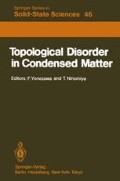Abstract
The dislocation model of liquids has been discussed by many authors [1–13]. There are, however, some criticisms [14,15] of the uniqueness of the definition of dislocations and the applicability of the concept of dislocations to such a high density of dislocations as 1014cm−2 which has been accepted by the dislocation model of liquids. There are also pessimistic views about the usefulness of the model. Namely, a liquid is occupied only by the core of dislocations, which is the most ambiguous in the theory of dislocations, so that the dislocation model does not contribute substantially to a better understanding of liquids.
Access this chapter
Tax calculation will be finalised at checkout
Purchases are for personal use only
Preview
Unable to display preview. Download preview PDF.
References
W. Shockley: L’État Solide, Report of the 9th International Solvay Conference, Brussels, 1951 (Stoops, 1952 ) p. 431
J. Friedel: Les Dislocations ( Gauthier-Villars, Paris 1956 ) p. 50
S. Mizushima: J. Phys. Soc. Japan 15, 70 (1960)
A. Ookawa: J. Phys. Soc. Japan 15/7I91 (1960)
D. Kuhlman-Wilsdorf: Phys. Rev. HO, A1599 (1965)
F.R.N. Nabarro: Theory of Crystal Dislocations ( Oxford University Press, Oxford 1967 ) p. 120
T. Ninomiya: J. Phys. Soc. Japan 44, 263; 269 (1978)
E.J. Jensen, W.D. Kristensen and R.M.J. Cotterill: Phil. Mag. 27, 623 (1973)
W.D. Kristensen, E. J. Jensen and R. M. J. Cotterill: Phil Mag. 30, 229 (1974)
R.M.J. Cotterill, W.D. Kristensen and E.J. Jensen: Phil. Mag. 30, 245 (1974)
J.M. Kosterlitz and D.J. Thouless: J. Phys. C6, 1181 (1973)
B.I. Halperin and D.R. Nelson: Phys. Rev. Lett. 41, 121 (1978)
D.R. Nelson and B.I. Halperin: Phys. Rev. BT9, 2459 (1979)
J.M. Ziman: Models of Disorder (Cambridge Univ. Press, Cambridge 1979 ) p. 56
F.C. Frank: The Physics of Metals, ed. by P.B. Hirsch ( Cambridge Univ. Press, Cambridge 1975 ) p. 68
See for example H. J. Ravechä and R.D. Mountain: Progress in Liquid Physics, ed. by C. Croxton ( John Wiley & Sons, New York 1978 ) p. 469
H. Suzuki: to be published
R.W. Builuffi and A.V. Granato: Dislocations in Solids Vol.4, ed. by F.R.N. Nabarro ( North-Holland, Amsterdam 1979 ) p. 26
T. Iida, Z. Morita and S. Takeuchi: J. Japan Inst. Metals 39, 1169 (1975) [in Japanese].
C.J. Vadovic and C.P. Colver: Phil. Mag. 24, 509 (1971)
H. Suzuki: Dislocation Modelling of Physical Systems, ed. by M.F.Ashby, R. Bullough, C.S. Hartey and J.P. Hirsch ( Pergamon, Oxford 1981 ) p. 400
J.W. Christian: The Theory of Transformations in Metals and Alloys ( Pergamon, Oxford 1965 ) p. 566
H. Suzuki: Proc. 4th Int. Conf. on Rapidly Quenched Metals (Japan Inst. Metals, Sendai 1982 ) p. 225
T. Matsuo and H. Suzuki: to be published.
T. Ninomiya: J. Phys. Soc. Japan 36, 399 (1974)
R. Yen, J.M. Liu, H. Kurz, and N. Bloembergen: Appl. Phys. A27, 153 (1982)
Author information
Authors and Affiliations
Editor information
Editors and Affiliations
Rights and permissions
Copyright information
© 1983 Springer-Verlag Berlin Heidelberg
About this paper
Cite this paper
Suzuki, H. (1983). Dislocation Model of Liquids — Basic Concepts and Phenomena Related to Atomic Motion. In: Yonezawa, F., Ninomiya, T. (eds) Topological Disorder in Condensed Matter. Springer Series in Solid-State Sciences, vol 46. Springer, Berlin, Heidelberg. https://doi.org/10.1007/978-3-642-82104-2_17
Download citation
DOI: https://doi.org/10.1007/978-3-642-82104-2_17
Publisher Name: Springer, Berlin, Heidelberg
Print ISBN: 978-3-642-82106-6
Online ISBN: 978-3-642-82104-2
eBook Packages: Springer Book Archive

